Part 1: Results of Crown entity audits
1.1
In this Part, we discuss the results of our 2010/11 audits of 69 Crown entities (see the Appendix).1
1.2
We also report our assessments and grades of the management control environments, financial information systems, and service performance information and associated systems and controls for 63 of the Crown entities. Six Crown entities were disestablished in 2010/11, and we do not grade disestablished entities.
About Crown entities
1.3
There are more than 2700 Crown entities, including 2460 school boards of trustees. Crown entities have a wide range of roles, functions, and responsibilities, and different degrees of autonomy. The Auditor-General is the statutory auditor of all Crown entities and their subsidiaries.
1.4
The Crown Entities Act 2004 provides a framework for the establishment, governance, accountability, and operation of Crown entities.2 It sets out five categories of Crown entities:
- statutory entities:
- Crown agents, such as the Accident Compensation Corporation and DHBs;
- autonomous Crown entities, such as the Standards Council of New Zealand and the New Zealand Symphony Orchestra; and
- independent Crown entities, such as the Law Commission;
- Crown entity companies, including Crown research institutes (CRIs);
- Crown entity subsidiaries;
- school boards of trustees; and
- tertiary education institutions (polytechnics, universities, and wānanga).
1.5
There have been several structural changes for Crown entities during 2010/11, in response to Government priorities, including disestablishing and establishing entities (see paragraph 1.9).
Audit results
2010/11 audit reports
1.6
We audited 69 Crown entities3 in 2010/11, including final audits for six entities that were disestablished during the year. We issued 68 unmodified audit opinions and one modified opinion.
1.7
We issued the New Zealand Fire Service Commission with a modified audit opinion because its 2010/11 performance data was not comparable to its 2009/10 data. Industrial action in 2009/10 meant that the Commission's non-financial performance information for 2009/10 was incomplete. The 2010/11 data was complete, but could not be directly compared to the 2009/10 data.
1.8
We included "emphasis of matter" paragraphs in our audit reports in 2010/11 to draw attention to:
- uncertainties associated with the Canterbury earthquakes (two emphasis of matter paragraphs for the Earthquake Commission);
- disclosures about the grounding of the container vessel Rena (the New Zealand Oil Pollution Fund);
- a high degree of uncertainty about the value of unlisted investments that could have a material effect on the financial statements (Public Trust and Group, and New Zealand Venture Investment Fund Limited and Group); and
- the "going concern" assumption appropriately not being used because the public entity was disestablished (six Crown entities were disestablished during the year) or expected to be disestablished in the near future (Crown Health Financing Agency, Health Sponsorship Council, Charities Commission, Mental Health Commission, and Alcohol Advisory Council of New Zealand).
Final audits for disestablished Crown entities
1.9
We carried out final audits for six Crown entities4 that were disestablished during 2010/11:
- The Electoral Commission was disestablished on 30 September 2010 and its functions were transferred to the new Electoral Commission, established on 1 October 2010.
- The Electricity Commission was disestablished on 31 October 2010 and its functions were transferred to the new Electricity Authority, established on 1 November 2010.
- The Environmental Risk Management Authority was disestablished on 30 June 2011 and its functions were transferred to the Environmental Protection Authority, established on 1 July 2011.
- The Foundation for Research, Science and Technology was disestablished on 31 January 2011, along with the Ministry of Research, Science and Technology, and the two were merged on 1 February 2011 to form the new Ministry of Science and Innovation.
- The Legal Services Agency was disestablished on 30 June 2011 and its functions were transferred to the Ministry of Justice on 1 July 2011.
- The Securities Commission was disestablished on 30 April 2011 and its functions were transferred to the new Financial Markets Authority, established on 1 May 2011.
1.10
For all six final audits, our audit reports included "emphasis of matter" paragraphs highlighting that the financial statements were appropriately prepared on a disestablishment basis.
1.11
We did not assess the environment, systems, and controls of the disestablished entities when we carried out the final audit. This is because the grades we give reflect our recommendations for improvement, and deficiencies identified during the final audit of a disestablished entity may or may not be relevant to any new or ongoing entity.
1.12
However, we did report our audit findings and any significant issues to the responsible Minister and to the new entity where appropriate. We also commented on the operation of the environment, systems, and controls during the disestablishment period.
1.13
Overall, our auditors found that, for all six disestablished entities, the management control environment and internal controls continued to operate effectively during the year. Other matters our auditors reported included that:
- one entity had difficulty in retaining staff in the months leading to disestablishment, including finance staff, which affected its ability to respond to the audit in a timely way; and
- another entity had limited reporting of its progress towards desired outcomes and a lack of clear reporting of actual activity and achievement during the year.
Matters of audit interest
1.14
The Government's focus on lifting the performance of the public sector, while reducing the rate of spending, includes an expectation that Crown entity boards deliver improved performance and greater value for money.
1.15
In 2010/11, our auditors focused on a range of risks for Crown entities, including the need for them to effectively govern and manage change and improvement processes while maintaining effective controls and core services in a fiscally constrained environment.
Financial sustainability
1.16
Ongoing financial sustainability was a risk for six Crown entities. Reasons for financial pressures included reduced fee revenue, exchange rate pressures, and increasing operating costs within static funding. For all six, our auditors concluded that the going concern assumption was appropriate for 2010/11. This means that the auditor concluded that the entity could continue operating within its means, without additional government support, for at least the next 12 months.5 We drew this heightened risk to the attention of the entity and to the respective Ministers and monitoring departments.
1.17
We will continue to monitor the financial performance of Crown entities to ensure that the going concern assumption is appropriately used in 2011/12.
Canterbury earthquakes
1.18
Many Crown entities were affected by the Canterbury earthquakes. Those effects included reduced revenue and/or increased expenditure, and damaged buildings, equipment, or other assets. There was a significant effect on the Earthquake Commission, including a much expanded role and major financial implications, such as outstanding claims liabilities and associated reinsurance recoveries.
Other matters
1.19
Other matters of interest that our auditors reported to the managers of Crown entities, and the number of Crown entities that each applied to, included:
- legislative compliance – seven entities breached legislation and, in each instance, had responded to the incident appropriately and planned action to avoid re-occurrence, while a further eight entities needed to improve their compliance monitoring systems and processes;
- related-party transactions – eight entities needed to ensure that all interests of board members and senior staff members are identified and disclosed so that potential conflicts can be monitored and appropriately managed;
- sensitive expenditure – seven entities needed to improve policies and/or processes (for example, to ensure that there is appropriate approval or more consistent application of policies throughout the entity);
- risk management – seven entities needed to prepare, improve, or fully implement an appropriate risk management policy and/or framework;
- fraud awareness – four entities needed to update fraud policies or carry out fraud risk assessments;
- asset management – four entities needed to prepare or implement asset management plans;
- business continuity – three entities needed to prepare or implement business continuity and disaster recovery plans; and
- procurement – three entities needed to update and/or consistently implement appropriate procurement policies and practices.
Environment, systems, and controls
1.20
As part of the annual audit, we examine, assess, and grade Crown entities' environment, systems, and controls for managing and reporting financial and service performance information.
1.21
Our auditors recommend improvements to ensure that there are effective internal controls for sound management and good governance, and to help entities to manage risks (such as errors and potential fraud).
1.22
This is the fifth year that we have used our current assessment framework to support the continued improvement of public entities. We assess three aspects:
- the management control environment;
- financial information systems and controls; and
- service performance information and associated systems and controls.
1.23
If auditors identify deficiencies in any of these aspects, they will recommend improvements. The grades assigned reflect the recommendations for improvement as at the end of the financial year (see Figure 1).
1.24
Fluctuations in grades can occur from year to year – for example, because of changes in the operating environment, organisational structure, good practice expectations, or auditor emphasis. How an entity responds to the auditor's recommendations for improvement is more important than the grade change from year to year. Consequently, the long-term trend in grade movement is a more useful indicator of progress than year-to-year grade changes.
Figure 1
Grading scale for assessing Crown entities' environment, systems, and controls
| Grade | Explanation of grade |
|---|---|
| Very good | No improvements are necessary. |
| Good | Improvements would be beneficial and we recommend that the entity address these. |
| Needs improvement | Improvements are necessary and we recommend that the entity address these at the earliest reasonable opportunity. |
| Poor | Major improvements are required and we recommend that the entity urgently address these. |
1.25
We report our assessments to the entity, the responsible Minister, the relevant select committee, and relevant monitoring agency. We also advise the central agencies – the Treasury, the State Services Commission, and the Department of the Prime Minister and Cabinet.
1.26
There have been changes to the size of the Crown entity group in recent years, with entities established and disestablished. The data in Figures 3, 5, and 7 below is for the group as it was constituted each year. We also compare Crown entities' grades for 2010/11 with those of other types of central government entities in Figures 4, 6, and 8.
Grades for 2010/11
1.27
We assessed and graded 63 Crown entities in 2010/11. We did not grade the six disestablished Crown entities (see paragraph 1.11). Figure 2 sets out a summary of the grades for 2010/11 for the three aspects that we assess.
Figure 2
Summary of Crown entities' grades for 2010/11, as percentages
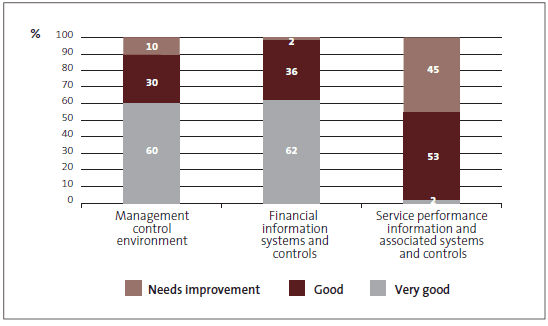
1.28
The results for 2010/11 show that almost all Crown entities have sound management control environments and financial information systems and controls.
1.29
However, we recommended that 45% of Crown entities improve their service performance information and reporting. Crown entities have been focused on improving this aspect, and eight entities improved their grades from "Needs improvement" in 2009/10 to "Good" in 2010/11.
Management control environment
1.30
The management control environment of an entity is especially important in times of change and restructuring. With an emphasis now on shared "back office" functions, entities need to maintain a sound control environment to ensure that risks are well managed.
1.31
Figure 3 shows grades for Crown entities' management control environment for the five years to 2010/11.
Figure 3
Grades for Crown entities' management control environment, 2006/07 to 2010/11, as percentages
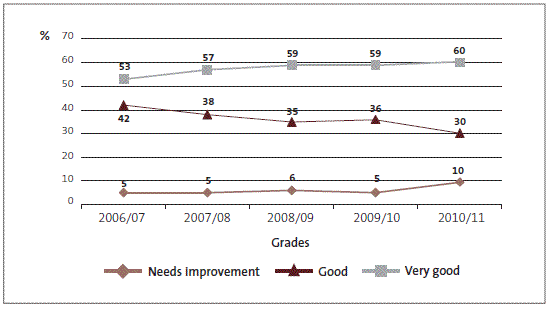
1.32
We graded the management control environment of 90% of the Crown entities as "Very good" or "Good". A "Very good" grade means that the appointed auditor did not recommend any improvements. A "Good" grade indicates that we did not have any significant concerns but that the appointed auditor recommended improvements that would be beneficial.
1.33
Four entities improved their grades from "Good" in 2009/10 to "Very good" in 2010/11.
1.34
The number of entities we graded as "Needs improvement" increased from three in 2009/10 to six in 2010/11.
1.35
Three of the entities that we graded as "Needs improvement" in 2010/11 had also been graded as "Needs improvement" in 2009/10. These entities had only partially resolved the deficiencies we identified in 2009/10. We expect entities to address the matters raised by our auditors and make the necessary improvements. We will continue to monitor how these entities respond to our recommendations for improvement.
1.36
The other three entities that we graded "Needs improvement" in 2010/11 included:
- A new entity that was still implementing its systems and processes, and an entity that underwent significant organisational change during the year. A "Needs improvement" grade in these circumstances is not unusual. We expect to see progress in responding to our recommendations for improvement in 2011/12 as new policies, systems, and controls are prepared and embedded.
- An entity where, although it had addressed some of our recommendations from previous years, there were still some outstanding issues. We will continue to monitor its response to our recommendations for improvement.
Comparing grades between types of entities
1.37
Figure 4 compares the 2010/11 management control environment grades of the 63 Crown entities with the grades for other types of central government entities (37 government departments, eight CRIs, 20 DHBs, and 16 State-owned enterprises).
Figure 4
Grades for management control environment, 2010/11, by type of entity, as percentages
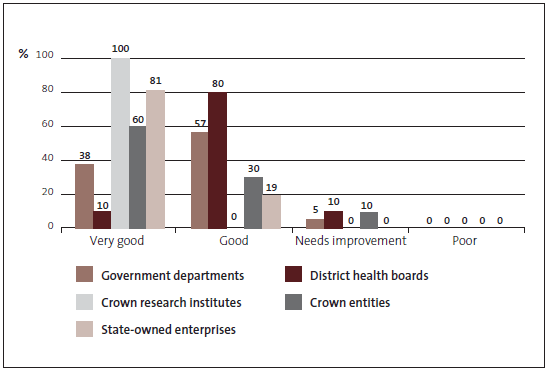
1.38
Figure 4 shows that, of all the entities where we graded the management control environment, at least 90% were graded as either "Very good" or "Good". Overall, central government entities have sound management control environments. CRIs stand out, with all eight CRIs receiving "Very good" grades in 2010/11. Crown entities other than DHBs and CRIs are toward the middle of the range for the number of those graded as "Very good".
Financial information systems and controls
1.39
Figure 5 shows grades for Crown entities' financial information systems and controls for the five years to 2010/11.
Figure 5
Grades for Crown entities' financial information systems and controls, 2006/07 to 2010/11, as percentages

1.40
Figure 5 shows that, in the past five years, we have graded the financial information systems and controls of at least 95% of Crown entities as either "Very good" or "Good". We have consistently found that the financial information systems and controls of most Crown entities are sound. In 2010/11, 98% were graded "Very good" or "Good".
1.41
Between 2009/10 and 2010/11, three entities moved from "Very good" to "Good" and three entities improved their grades from "Good" to "Very good". We expect fluctuations between the "Very good" and "Good" grades and are not concerned, as they tend to reflect changes in the operating environment, organisational structure, good practice expectations, or auditor emphasis.
1.42
We graded only one entity as needing to improve its financial information systems and controls in 2010/11. This was the new entity that was still implementing its systems and processes. It was also graded as "Needs improvement" for its management control environment. We expect to see improvements as its systems and processes become fully established and embedded.
Comparing grades between types of entities
1.43
Figure 6 compares the 2010/11 financial information systems and controls grades of the 63 Crown entities with the grades for other types of central government entities (37 government departments, eight CRIs, 20 DHBs, and 16 State-owned enterprises).
Figure 6
Grades for financial information systems and controls, 2010/11, by type of entity, as percentages
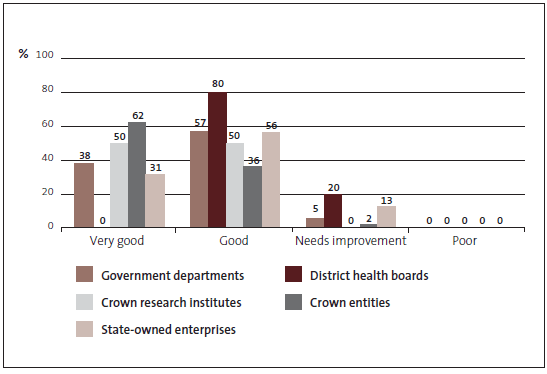
1.44
Figure 6 shows that most central government entities have sound financial information systems and controls. We recommended that improvements were necessary for two of the 16 State-owned enterprises (13%) and four of the 20 DHBs (20%).
1.45
We graded 39 of the Crown entities (62%) as "Very good", which means that our auditors did not recommend any improvements. This result shows a strong performance by Crown entities compared to the other types of entities in the central government sector.
Service performance information and associated systems and controls
1.46
Good-quality service performance information and reporting enables public entities to account for, and be held to account for, the effective and efficient use of resources and achievement of their objectives. It enables Parliament and the public to see what an entity said it would do, what it achieved, and the difference it made.
1.47
In Part 9 of Central government: Results of the 2010/11 audits (Volume 1), we discuss our work to help public entities improve their performance information and reporting.
1.48
Figure 7 shows the grades for Crown entities for the three years to 2010/11.
Figure 7
Grades for Crown entities' service performance information and associated systems and controls, 2008/09 to 2010/11, as percentages

1.49
Crown entities have continued to make steady progress in improving their service performance reporting.
1.50
In 2010/11, we did not grade any Crown entities as "Poor", compared to one graded "Poor" in 2009/10. We graded 33 of the 626 Crown entities (53%) as "Good" and one entity (2%) as "Very good" (the same entity as in 2009/10). We graded the remaining 28 entities (45%) as "Needs improvement".
1.51
Eight entities improved their grades from "Needs improvement" in 2009/10 to "Good" in 2010/11, which reflects the progress that Crown entities are making in improving their service performance information and reporting.
Comparing grades between types of entities
1.52
Figure 8 compares Crown entities' grades for service performance information and associated systems and controls in 2010/11 with the grades for 20 DHBs and 37 government departments, the other entities for which we assess this aspect.
Figure 8
Grades for service performance information and associated systems and controls, 2010/11, by type of entity, as percentages
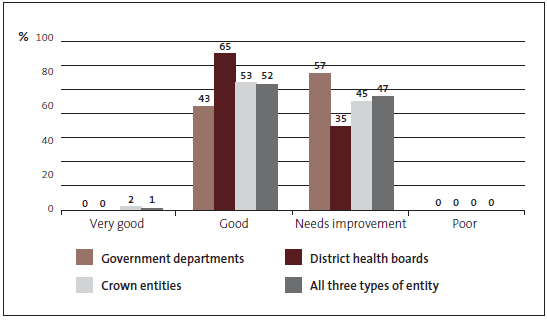
1.53
Figure 8 shows that we graded 52% of all these entities' service performance information and reporting as "Good" (and one as "Very good") in 2010/11. Crown entities' performance information is similarly graded to that of the other groups, except DHBs.
1.54
The results for DHBs are particularly positive, because in 2009/10 all DHBs were graded either "Needs improvement" or "Poor".7 We discuss this significant improvement in greater detail in our separate report Health sector: Results of the 2010/11 audits.
1.55
We graded the service performance information of 21 government departments (57%) as "Needs improvement" in 2010/11.8
Phasing in a revised auditing standard
1.56
In Part 9 of Central government: Results of the 2010/11 audits (Volume 1), we discussed the phased implementation of our revised standard for auditing service performance reports.
1.57
The revised standard requires auditors to modify their audit opinion if the performance information in the annual report does not, in their opinion, fairly reflect the entity's performance for the year. This includes assessing the appropriateness of performance information and verifying key aspects of it. Under the previous standard, there was little scope for auditors to modify their audit opinion if the content of the performance report was inadequate.
1.58
In 2010/11, nine Crown entities were audited under the revised standard. They were:
- Accident Compensation Corporation;
- Housing New Zealand Corporation;
- Legal Services Agency;
- New Zealand Fire Service Commission;
- New Zealand Lotteries Commission;
- New Zealand Trade and Enterprise;
- New Zealand Transport Agency;
- Public Trust; and
- Tertiary Education Commission.
1.59
One year ago, we concluded that five of these entities were at risk of receiving a modified audit opinion if they did not improve their performance reporting in 2011. During the year, our auditors maintained contact with the five entities, offering recommendations for improvement, reviewing draft accountability documents, monitoring progress, and testing systems and controls for reporting non-financial performance information. The entities responded well and made significant improvements.
1.60
As a result, we were able to issue unmodified opinions on the service performance for eight of the nine entities. Only one entity received a modified opinion, and we have commented on this entity in paragraph 1.7.
Our focus for 2011/12 and beyond
1.61
We are continuing to focus on improving the quality of service performance reporting. Our revised standard for auditing service performance reports applies to a further 21 Crown entities in 2011/12.
1.62
Our audit work and wider work programme in 2011/12 and 2012/13 will be underpinned by the theme Our future needs – is the public sector ready? We want our work on a range of issues and initiatives related to this theme to make a lasting difference to the public sector and to the public.
1: District health boards and Crown research institutes are also Crown entities, but we have discussed them separately in other reports. It makes sense to compare district health boards to one another, but little sense to compare them with other Crown entities. The same applies to Crown research institutes.
2: Many Crown entities also have their own enabling legislation.
3: The Financial Markets Authority was established on 1 May 2011. Its first audit will be for the 14 months to 30 June 2012.
4: On 1 July 2011, the Accounting Standards Review Board transitioned to the External Reporting Board. The Accounting Standards Review Board was not disestablished and did not require a final audit.
5: AG ISA (NZ) 570: Going Concern, page 3-4302 of The Auditor-General's Auditing Standards (March 2011), available at www.oag.govt.nz.
6: For service performance information and associated systems and controls, we assessed one less entity. The Standards Council of New Zealand had an exemption, under the Crown Entities Act 2004, and did not need to include a statement of forecast service performance in its Statement of Intent. We therefore did not grade this aspect for that entity, and our audit opinion covered only the financial statements.
7: Central government: Results of the 2009/10 audits (Volume 2), page 8.
8: Although there has been an improvement in departments' grades since 2009/10, the results for the other types of entities (both Crown entities and DHBs) show stronger performance in 2010/11. (See Figure 7 in Central government: Results of the 2009/10 audits (Volume 2), page 20.
page top